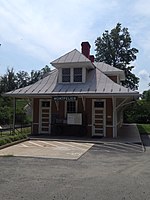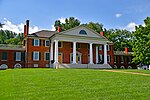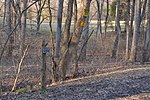Burlington (Barboursville, Virginia)

Burlington is a historic plantation house located near Barboursville, Orange County, Virginia. The main house was built in 1851–1852, and is a two-story, three-bay, T-shaped residence with a shallow hipped roof in the Greek Revival style. It has a traditional I-house plan with an ell addition. The front facade features a portico with six Greek Ionic order columns with a plain entablature. It has a Jeffersonian Chinese lattice balcony cantilevered on the second floor. The exterior and interior detailing is derived almost entirely from Asher Benjamin's The Practical House Carpenter, 1830 edition. The house was built by James Barbour Newman, nephew of Governor James Barbour.It was listed on the National Register of Historic Places in 1994.
Excerpt from the Wikipedia article Burlington (Barboursville, Virginia) (License: CC BY-SA 3.0, Authors, Images).Burlington (Barboursville, Virginia)
Glenbrooke Lane,
Geographical coordinates (GPS) Address Nearby Places Show on map
Geographical coordinates (GPS)
| Latitude | Longitude |
|---|---|
| N 38.176388888889 ° | E -78.259722222222 ° |
Address
Glenbrooke Lane
Glenbrooke Lane
20142
Virginia, United States
Open on Google Maps





